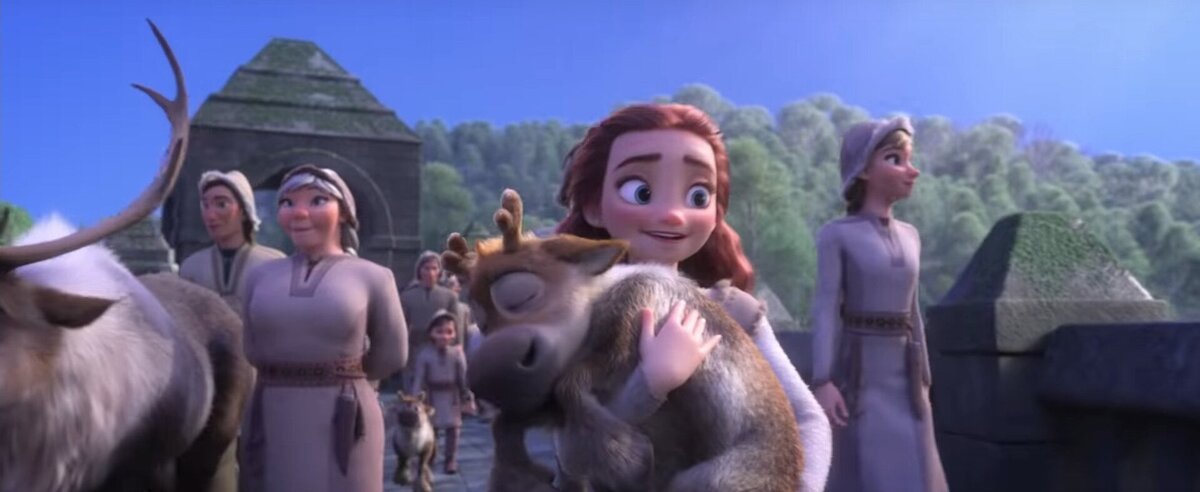Disney Worked with Indigenous Sámi People to Ensure Frozen II Was Culturally Sensitive


Frozen was a worldwide hit when it debuted in 2013, though it wasn’t without its flaws. No, we’re not talking about that awful troll song that stalls the second half of the movie, we’re talking about how the film handled (or didn’t handle) the use of indigenous Scandinavian elements. But while the first Frozen didn’t really acknowledge the indigenous peoples of Scandinavia, Frozen II is putting them front and center with the blessing and cooperation of the Sámi.
A quick warning before you read on: This article contains some spoilers based on already public Frozen II tie-in materials and speculation based on those materials, so if you want to go into the movie completely unspoiled, bookmark this article to read after you’ve seen it.
Indigenous culture has been part of the Frozen brand from the getgo. Remember that “nah nah yah hey ah nah” opening chorus of the film? It’s an evocative melody called “Vuelie” and it’s based on formerly outlawed indigenous vocal music of the Sámi of Scandanavia called jolk. “Vuelie” was composed and adapted by South Sámi musician and composer Frode Fjellheim. It’s a version of an older song called “Eatnemen Vuelie (Song Of The Earth). It’s a great opener but its use caused both confusion and controversy among audiences and indigenous people when Frozen first bowed in 2013.

The Northuldra in Frozen II.
There was a lot of chatter about Frozen‘s diversity and lack thereof back then. No women really spoke besides Anna and Elsa, there were no people of color, and the film used motifs and music from the Sámi people without any real acknowledgment of them. Along with the music, Kristoff, the reindeer-loving ice-seller wore clothes reminiscent of the Sámi, who herd reindeer. Kristoff could have been Sámi, as many of them look “Norweigian” thanks to assimilation, but still Frozen was a very white film, even with the musical and fashion nods to the indigenous culture.
Fast forward to the production of Frozen II, and things are very different. The film centers in part around Anna (Kristin Bell), Elsa (Idina Menzel), Kristoff (Johnathan Groff), and Olaf (Josh Gad) journeying to the enchanted forest north of Arendelle to find out why Elsa’s powers are doing strange things, and perhaps where they came from in the first place. This leads the gang to the fictional Northuldra people, who are based on the Sámi, as well as to trapped Arendelle citizens led by Mattias, a black character voiced by Sterling K. Brown.

Northuldra characters Honeymaren, Ryder, and Yelena.
In order to sensitively portray a people based on the Sámi, Disney entered into a contract with several Sami parliaments to affirm their ownership of their culture and worked with them to make sure the film respectfully portrayed indigenous people. That’s … a pretty huge improvement. Both this and the inclusion of a black character and several new female characters seems to indicate that Disney is actually learning from the criticisms of Frozen and adapting to be better.
This is good. It seems as if Disney is wedding many of the complaints about the first Frozen—both in terms of plotholes and its lack of diversity—and marrying them to make the sequel. The new film will not only answer many of the questions that audiences had after the first, like where on earth Elsa’s powers came from, but expand the world in diverse ways. Sadly, the stupid trolls are still around.
Frozen II isn’t just about Elsa and crew learning from indigenous people and saving them, it seems to also be about reconciliation and cultures finding common ground. I’m just guessing here, based on a few clues from the Big Golden Book version of the story that’s already available and which I’ve already read to my kid, but it may be revealed that Anna and Elsa’s mother is one of the Northuldra as well which would make Anna and Elsa part indigenous. Hopefully, the key to saving the day is characters learning who they are and celebrating their own power.

Queen Iduna, Elsa and Anna’s mother, in a Northuldra scarf.
There are still some iffy things here that we do have to acknowledge. While many of the characters are indigenous (or may be part indigenous), as far as I can tell their voice actors are not. This is excusable for the characters that have been established previously, but it does rankle a bit that Disney went to all this trouble to tell a story with indigenous elements and didn’t manage to get any indigenous people into the cast, as they did with Moana.
However, Disney did learn from the experience of making Moana and their work with indigenous people on that film to make Frozen II more inclusive in other ways. Along with working with Sámi representatives, they will also be dubbing the film in one Sami language (as they did with Maori, Tahitian and Hawaiian language dubs of Moana). They will also participate in cross-cultural learning initiatives.
Overall, the news that Disney took the time to communicate and work with indigenous people while making this move makes me happy and gives me a lot of hope for the film and for the future of inclusive filmmaking. I’m excited to see it and now the only thing I want to know is when Elsa and Honeymaren of the Northuldra will start dating.
(via Now Toronto, images: Disney)
Want more stories like this? Become a subscriber and support the site!
—The Mary Sue has a strict comment policy that forbids, but is not limited to, personal insults toward anyone, hate speech, and trolling.—
Have a tip we should know? [email protected]
